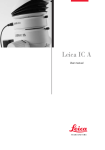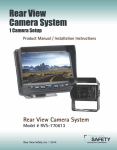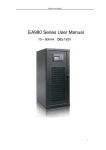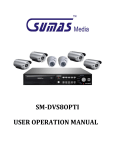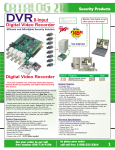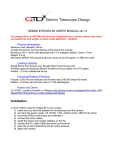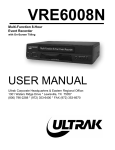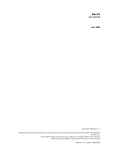Download MODEL NUMBER
Transcript
KC33W4MM 1/3" CCD BLACK-AND-WHITE PROFESSIONAL OBSERVATION SYSTEM CAMERA USER MANUAL Ultrak Worldwide Support Center Sales & Technical Support 1301 Waters Ridge Drive • Lewisville, TX 75057 (800) 796-2288 • (972) 353-6400 • FAX (972) 353-6670 KCMU000002 05/30/01 ISSUE 1 – May 2001 2001 BY ULTRAK ALL RIGHTS RESERVED PRINTED IN USA ULTRAK CORPORATE OFFICE 1301 WATERS RIDGE DRIVE LEWISVILLE, TX 75057 (972) 353-6500 ALL RIGHTS RESERVED. NO PART OF THIS PUBLICATION MAY BE REPRODUCED BY ANY MEANS WITHOUT WRITTEN PERMISSION FROM ULTRAK. THE INFORMATION IN THIS PUBLICATION IS BELIEVED TO BE ACCURATE IN ALL RESPECTS. HOWEVER, ULTRAK CANNOT ASSUME RESPONSIBILITY FOR ANY CONSEQUENCES RESULTING FROM THE USE THEREOF. THE INFORMATION CONTAINED HEREIN IS SUBJECT TO CHANGE WITHOUT NOTICE. REVISIONS OR NEW EDITIONS TO THIS PUBLICATION MAY BE ISSUED TO INCORPORATE SUCH CHANGES. USERS OF THIS PRODUCT ARE RESPONSIBLE FOR CHECKING AND COMPLYING WITH ALL FEDERAL, STATE, AND LOCAL LAWS AND STATUTES CONCERNING THE MONITORING AND RECORDING OF VIDEO AND AUDIO SIGNALS. ULTRAK SHALL NOT BE HELD RESPONSIBLE FOR THE USE OF THIS PRODUCT IN VIOLATION OF CURRENT LAWS AND STATUTES. ii KCMU000002 05/30/01 FCC COMPLIANCE STATEMENT INFORMATION TO THE USER: THIS EQUIPMENT HAS BEEN TESTED AND FOUND TO COMPLY WITH THE LIMITS FOR A CLASS B DIGITAL DEVICE, PURSUANT TO PART 15 OF THE FCC RULES. THESE LIMITS ARE DESIGNED TO PROVIDE REASONABLE PROTECTION AGAINST HARMFUL INTERFERENCE IN A RESIDENTIAL INSTALLATION. THIS EQUIPMENT GENERATES, USES, AND CAN RADIATE RADIO FREQUENCY ENERGY AND, IF NOT INSTALLED AND USED IN ACCORDANCE WITH THE INSTRUCTIONS, MAY CAUSE HARMFUL INTERFERENCE TO RADIO COMMUNICATIONS. HOWEVER, THERE IS NO GUARANTEE THAT INTERFERENCE WILL NOT OCCUR IN A PARTICULAR INSTALLATION. IF THIS EQUIPMENT DOES CAUSE HARMFUL INTERFERENCE TO RADIO OR TELEVISION RECEPTION WHICH CAN BE DETERMINED BY TURNING THE EQUIPMENT OFF AND ON, THE USER IS ENCOURAGED TO TRY TO CORRECT THE INTERFERENCE BY ONE OR MORE OF THE FOLLOWING MEASURES: - REORIENT OR RELOCATE THE RECEIVING ANTENNA - INCREASE THE SEPARATION BETWEEN THE EQUIPMENT AND RECEIVER - CONNECT THE EQUIPMENT INTO AN OUTLET ON A CIRCUIT DIFFERENT FROM THAT TO WHICH THE RECEIVER IS CONNECTED - CONSULT THE DEALER OR AN EXPERIENCED RADIO/TV TECHNICIAN FOR HELP CAUTION: CHANGES OR MODIFICATIONS NOT EXPRESSLY APPROVED BY THE PARTY RESPONSIBLE FOR COMPLIANCE COULD VOID THE USER’S AUTHORITY TO OPERATE THE EQUIPMENT. THIS CLASS B DIGITAL CANADIAN ICES-003. APPARATUS COMPLIES WITH CET APPAREIL NUMÉRIQUE DE LA CLASSE B EST CONFORME A LA NORME NMB-003 DU CANADA. iii KCMU000002 05/30/01 WARNING • TO REDUCE THE RISK OF FIRE OR ELECTRIC SHOCK, DO NOT EXPOSE THIS PRODUCT TO RAIN OR MOISTURE. • DO NOT INSERT ANY METALLIC OBJECT THROUGH VENTILATION GRILLS. CAUTION CAUTION RISK OF ELECTRIC SHOCK DO NOT OPEN CAUTION: TO REDUCE THE RISK OF ELECTRIC SHOCK, DO NOT REMOVE COVER (OR BACK). NO USER-SERVICEABLE PARTS INSIDE. REFER SERVICING TO QUALIFIED SERVICE PERSONNEL. EXPLANATION OF GRAPHICAL SYMBOLS The lightning flash with arrowhead symbol, within an equilateral triangle, is intended to alert the user to the presence of uninsulated "dangerous voltage" within the product's enclosure that may be of sufficient magnitude to constitute a risk of electric shock to persons. The exclamation point within an equilateral triangle is intended to alert the user to the presence of important operating and maintenance (servicing) instruction in the literature accompanying the product. iv KCMU000002 05/30/01 IMPORTANT SAFEGUARDS 1. READ INSTRUCTIONS – All the safety and operating instructions should be read before the unit is operated. 2. RETAIN INSTRUCTIONS – The safety and operating instructions should be retained for future reference. 3. HEED WARNINGS – All warnings on the unit and in the operating instructions should be adhered to. 4. FOLLOW INSTRUCTIONS – All operating and use instructions should be followed. 5. CLEANING – Unplug the unit from the outlet before cleaning. Do not use liquid cleaners or aerosol cleaners. Use a damp cloth for cleaning. See cleaning procedures under Maintenance. 6. WATER AND MOISTURE – Do not use this unit near water or in an unprotected outdoor installation, or any area which is classified as a wet location. 7. ACCESSORIES – Do not place this unit on an unstable stand, tripod, bracket, or mount. The unit may fall, causing serious injury to a person and serious damage to the unit. Use only with a stand, tripod, bracket, or mount recommended by the manufacturer, or sold with the product. Any mounting of the unit should follow the manufacturer’s instructions, and should use a mounting accessory recommended by the manufacturer. 8. POWER SOURCES – This unit should be operated only from the type of power source indicated on the marking label. 9. GROUNDING OR POLARIZATION – The power supply supplied with this unit may be equipped with a polarized alternating-current line plug (a plug having one blade wider than the other). This plug will fit into the power outlet only one way. This is a safety feature. If you are unable to insert the plug fully into the outlet, try reversing the plug. If the plug should still fail to fit, contact your electrician to replace your obsolete outlet. Do not defeat the safety purpose of the polarized plug. Alternately, this unit may be equipped with a 3-wire grounding-type plug, a plug having a third (grounding) pin. This plug will only fit into a groundingtype power outlet. This is a safety feature. If you are unable to insert the plug into the outlet, contact your electrician to replace your obsolete outlet. Do not defeat the safety purpose of the grounding-type plug. v KCMU000002 05/30/01 IMPORTANT SAFEGUARDS 10. POWER-CORD PROTECTION – Power supply cords should be routed so that they are not likely to be walked on or pinched by items placed upon or against them, paying particular attention to cords and plugs, convenience receptacles, and the point where they exit from the appliance. 11. Overloading – Do not overload outlets and extension cords as this can result in a risk of fire or electric shock. 12. Object and Liquid Entry – Never push objects of any kind into this unit through openings as they may touch dangerous voltage points or short-out parts that could result in a fire or electric shock. Never spill liquid of any kind on the unit. 13. Servicing – Do not attempt to service this unit yourself as opening or removing covers may expose you to dangerous voltage or other hazards. Refer all servicing to qualified service personnel. 14. Damage Requiring Service – Unplug the unit from the outlet and refer servicing to qualified service personnel under the following conditions: a. b. c. d. When the power-supply cord or plug is damaged. If liquid has been spilled, or objects have fallen into the unit. If the unit has been exposed to rain or water. If the unit does not operate normally by following the operating instructions. Adjust only those controls that are covered by the operating instructions as an improper adjustment of other controls may result in damage and will often require extensive work by a qualified technician to restore the unit to its normal operation. e. If the unit has been dropped or the enclosure has been damaged. f. When the unit exhibits a distinct change in performance - this indicates a need for service. 15. Replacement Parts – When replacement parts are required, be sure the service technician has used replacement parts specified by the manufacturer or have the same characteristics as the original part. Unauthorized substitutions may result in fire, electric shock or other hazards. 16. Safety Check – Upon completion of any service or repairs to this unit, ask the service technician to perform safety checks to determine that the unit is in proper operating condition. 17. Lightning – For added protection of this unit during a lightning storm, or when it is left unattended and unused for long periods of time, unplug it from the wall outlet and disconnect the cable system. This will prevent damage to the unit due to lightning and power-line surges. vi KCMU000002 05/30/01 TABLE OF CONTENTS SECTION 1: INTRODUCTION...............................................................1 PRODUCT DESCRIPTION...............................................................1 FEATURES .......................................................................................1 SECTION 2: CONTROLS AND CONNECTIONS...................................3 CAMERA – FRONT / BACK..............................................................3 CAMERA – TOP / BOTTOM .............................................................4 CAMERA – SIDE...............................................................................4 SECTION 3: INSTALLATION AND ADJUSTMENT ..............................5 CONTENTS OF PACKAGE ..............................................................5 BASIC INSTALLATION.....................................................................6 MANUAL IRIS LENS ADJUSTMENT (OPTIONAL LENS) ...............9 DC TYPE AUTO IRIS LENS INSTALLATION AND ADJUSTMENT (OPTIONAL LENS) ................................................10 BACKFOCUS ADJUSTMENT.........................................................11 AUDIO DEFEAT ADJUSTMENT ....................................................12 SECTION 4: TROUBLESHOOTING AND MAINTENANCE ................14 TROUBLESHOOTING ....................................................................14 PREVENTIVE MAINTENANCE ......................................................15 SPECIFICATIONS ..........................................................................16 vii KCMU000002 05/30/01 THIS PAGE INTENTIONALLY LEFT BLANK. viii KCMU000002 05/30/01 SECTION 1: INTRODUCTION PRODUCT DESCRIPTION The KC33W4MM camera is a high performance 1/3" black-and-white observation camera designed for use with Ultrak observation systems. It provides a low-cost solution for closed-circuit television (CCTV) and security surveillance applications. FEATURES The KC33W4MM camera includes the following features: • 1/3" CCD Image Sensor – A professional-level camera chip that achieves a very high quality picture. • 4mm Fixed Focus Lens • Support for Standard CS- or C-mount Lens • Electronic Iris – Automatically adjusts the camera for changes in lighting to ensure an optimal picture at all times. • Microphone – Allows for the monitoring of audio at the camera location. • Audio Defeat Switch – Allows the audio feature of the camera to be disabled. This is important in states or cities that do not allow audio monitoring and recording. 1 KCMU000002 05/30/01 FEATURES, CONTINUED • Interphone Input – Allows for accessory connections, such as motion sensors, alarm contacts and two-way intercom boxes. • Camera Stand/Mount – Allows the camera to be mounted to shelves, walls, ceilings and many other structures. • Excellent Picture Quality • Single Cable – One cable transmits all information including video, audio and alarm signals. IMPORTANT: • To reduce the risk of fire or electric shock, do not expose this product to rain or moisture. • The KC33W4MM camera may be used in outdoor settings only when used with approved camera housing. Contact your sales representative for information. • The KC33W4MM camera should never be used outdoors without a housing. • The user of this equipment is responsible for checking and complying with local, state, and federal laws and statutes concerning the recording and monitoring of audio signals. 2 KCMU000002 05/30/01 SECTION 2: CONTROLS AND CONNECTIONS CAMERA – FRONT / BACK FRONT BACK EI 2 3 IRIS LEVEL ON OFF 7 MONITOR INTERPHONE 1 4 5 6 1 Backfocus Ring Used to adjust the focus of the lens. 2 Back-focus Lock Screw Used to secure the backfocus setting. 3 Microphone Gathers sound at the camera location and transmits the sound to the monitor. 4 EI Switch Used to turn the electronic iris function ON or OFF. 5 Monitor Port Used to connect the cable from the monitor. 6 Interphone Port Used to connect optional accessories. Up to two alarming devices may be connected to each camera with the purchase of an optional two-way connector. Motion sensors, alarm contacts, and two-way intercom boxes can also be connected to this port. Contact your sales representative to purchase optional accessories. 7 Iris Level Control Used to adjust the picture for optimal quality when used with a DC iris lens. 3 KCMU000002 05/30/01 CAMERA – TOP / BOTTOM TOP BOTTOM 1 8 8 8 Mounting Hole with 1/4" – 20 UNC Threads The camera stand screws into this hole. CAMERA – SIDE 9 9 DC Iris Lens Port Used to connect a DC iris lens. 4 KCMU000002 05/30/01 SECTION 3: INSTALLATION AND ADJUSTMENT CONTENTS OF PACKAGE Installation of the KC33W4MM camera must be performed in accordance with all local and national electrical and mechanical codes. Carefully remove the camera and its accessories from the carton and verify that they were not damaged in shipment. The contents of the package include: 1. Black-and-white CCD camera with CS-mount 2. Fixed focus 4mm lens (KOAL04MM) 3. Connector (for DC type auto iris lens) 4. C-mount adapter 5. Camera stand/mount 6. 60-foot camera cable 7. User Manual 5 KCMU000002 05/30/01 BASIC INSTALLATION After unpacking and identifying the package contents, perform the following steps to connect the camera to an observation system. 1. Locate the following items which may be needed during installation but are NOT supplied with the KC33W4MM camera. • Observation monitor • Welder’s glass • Mounting hardware • Tools 2. Select a suitable location for the camera, noting that the supplied camera cable is 60 feet long. IMPORTANT: If installing the camera more than 60 feet from the monitor, contact your sales representative to purchase longer cables. 3. Test each camera and cable at the monitor location prior to mounting the cameras and running cables. 4. Use a suitable fastener and necessary tools to mount the camera stand to a structural object, such as a wall stud, shelf, or ceiling rafter, that can support the weight of the camera and mount. IMPORTANT: The maximum recommended load of the mounting bracket is 11 lbs (5kg). 6 KCMU000002 05/30/01 BASIC INSTALLATION, CONTINUED 5. The KC33W4MM observation camera has a 1/4" – 20 UNC mounting hole located at the top and the bottom of the camera housing. Mount the camera on the stand by threading the camera onto the mounting bolt. Adjust the camera’s position and tighten the wing nut to hold the position firmly in place. REMINDER: Do not aim or point the camera towards the sun or into a strong light. 6. The KC33W4MM camera supports both C- and CS-mount lenses. The KAOL04MM lens supplied with the camera is a CS-mount lens. When using a CS-mount lens, attach the lens directly on the backfocus ring. Backfocus Ring Backfocus Lock Screw ( CS-MOUNT LENS ) OR Camera Mounting Bracket C-Mount Adapter ( C-MOUNT LENS ) When using a C-mount lens, attach the C-mount adapter to the backfocus ring before attaching the C-mount lens. 7 KCMU000002 05/30/01 BASIC INSTALLATION, CONTINUED 7. The KOAL04MM lens supplied with the camera is a DC type fixed focus lens. No additional connections are required. DC Iris Lens Connector If using a DC type auto iris lens, plug the cable into the DC lens connector. 8. Route the cable from the monitor location to the camera location. IMPORTANT: Care should be taken when routing the cable from the monitor to the camera. Try not to put unnecessary strain on the cable or connectors. Do not place the cable next to fluorescent lights as interference may result. Do not use staples to support the cable as they may damage the cable. If the provided camera cable is not long enough, do not substitute a telephone cable as it could damage the camera and/or the monitor. Contact your authorized sales representative to purchase longer cables. 9. Plug the cable into the connector port labeled MONITOR on the back of the camera. EI IRIS LEVEL ON OFF MONITOR INTERPHONE MONITOR port 8 KCMU000002 05/30/01 BASIC INSTALLATION, CONTINUED 10. Plug the other end of the camera cable into the CAMERA port on the back of the monitor. 11. Plug the monitor’s power cable into a suitable wall outlet. 12. Turn the monitor ON. The monitor should display images for the connected camera(s). For more information on system installation and camera display options, refer to the observation monitor or system manual. 13. Adjust the lens focus and iris control for an optimum picture. MANUAL IRIS LENS ADJUSTMENT (OPTIONAL LENS) A manual iris lens is used in indoor applications where lighting from windows can considerably affect the light level of the room. When using a manual iris lens, perform the following: 1. Set the EI switch to ON. 2. Turn the iris ring on the lens to the fully open position. 3. Focus the lens to obtain optimum picture. 4. To increase the camera’s depth of field, slightly close the manual iris by approximately 5-10%. 9 KCMU000002 05/30/01 DC TYPE AUTO IRIS LENS INSTALLATION AND ADJUSTMENT (OPTIONAL LENS) The KC33W4MM camera supports DC auto iris lenses. Perform the following steps to install and adjust a DC type auto iris lens: 1. Thread the DC iris lens onto the lens mount on the front of the camera. 2. If using an Ultrak lens, skip to step 3. If using a non-Ultrak lens, use the manufacturer’s instructions to solder the connector supplied with the camera to the lens control wires. The pin-out and wire color-coding for DC type auto iris lenses can vary from one manufacturer to another. 3. Plug the connector into the DC iris jack on the side of the camera. The connector is keyed and can only be inserted into the jack one way. 4. Make sure that the EI switch located on the back of the camera is set to OFF. 5. Apply power to the camera. 6. Adjust the DC type auto iris lens for an optimum picture using the IRIS LEVEL control on the back of the camera. 10 KCMU000002 05/30/01 BACKFOCUS ADJUSTMENT Although the camera backfocus was adjusted by the manufacturer prior to shipping, it may be necessary to make modifications. For best results, perform backfocus adjustments at night or while using a #6 or #8 welder’s glass in front of the lens. The focus of the camera will change slightly if the camera iris was adjusted on a light scene and then changes to a dark scene. However, the camera will remain in focus if the iris was focused on a dark scene and the scene lightens. To make backfocus adjustments, perform the following: 1. Mount the lens on the camera and apply power. 2. Open the camera iris by turning the lens level control counterclockwise. 3. If a picture is visible, focus on the scene. Open the lens as wide as possible by placing a welder’s glass in front of the lens. 4. When the iris is open to the widest point, readjust the focus for a clear picture. If a clear picture is not visible, set the focus ring to mid-range. 5. Loosen the backfocus lock screw. 6. Adjust the backfocus ring for a clear picture. 7. Tighten the backfocus screw lock. 8. Fine-tune the focus with the focus ring on the lens. 9. Remove the welder’s glass from in front of the lens. 10. Adjust the level control of the lens for the best picture quality. 11 KCMU000002 05/30/01 AUDIO DEFEAT ADJUSTMENT It may be necessary to disable the audio from the camera to comply with some state and local laws and regulations. To disable audio, perform the following: 1. Turn the monitor’s main power switch OFF. 2. Remove the camera from the camera stand. 3. Disconnect the cable(s) from the back of the camera. 4. Remove the two screws on top of the camera. 5. Remove the top half of the camera case. 6. If an intercom station is not used: Locate the audio disable jumper on the right back portion of the camera. Remove the audio jumper using needle-nose pliers. Replace the jumper on the center pin and the OFF pin, as illustrated. Move the jumper from the ON and center position to the OFF and center position to disable the audio from the camera to the observation monitor. AUDIO ON 12 OFF KCMU000002 05/30/01 AUDIO DEFEAT ADJUSTMENT, CONTINUED If an intercom station is used: Disconnect the microphone connector by grasping the black-and-white wire located next to the connector and pulling. The connector should release with minimum effort. Coil the microphone cable and cover the connector with electrical tape to avoid possible electrical shorts. Leave the jumper in the ON and center position to use the audio from the intercom station to the observation monitor. Disconnect the microphone cable to disable audio from the camera. Microphone cable and connector black & white wires AUDIO ON OFF 7. Replace the cover and cover screws. 8. Reconnect the cable(s) to the back of the camera. 9. Turn the monitor’s main power switch ON. 13 KCMU000002 05/30/01 SECTION 4: TROUBLESHOOTING AND MAINTENANCE TROUBLESHOOTING If you experience difficulties operating your camera, refer to the following. If the guidelines do not enable you to solve the problem, contact an authorized technician. PROBLEM CHECK • Is the system plugged in? • Is the main power switch on the observation monitor ON? • Does the outlet have power? • Is the monitor turned ON? • Is anything blocking the camera lens? • Is the camera cable firmly plugged into the monitor and camera? • Are all connections firmly in place on the back of the monitor and at all accessories? • If the monitor offers quad display and is in quad display mode, is the flashing square in the correct quadrant? • Is the volume control set at an appropriate level? Video but No Control • Power down the system for one minute, then turn the system ON. Squealing Noise at the Monitor on a Camera • The camera is too close to the monitor and/or the volume control on the monitor is too high. No Power Power but No Picture No Audio or Video No Audio 14 KCMU000002 05/30/01 PREVENTIVE MAINTENANCE Following the preventive maintenance schedule allows detection and correction of minor faults before they become serious and cause equipment failure. Every three months, perform the following: 1. Inspect all connecting cables for deterioration or other damage. 2. Clean components with a clean damp cloth. 3. Verify that all mounting hardware is secure. 15 KCMU000002 05/30/01 SPECIFICATIONS Power Source 15V dc (from monitor) Power Consumption 2W max. Image Sensor 1/3" interline transfer CCD Picture Element 512H x 492V Image Sensor Area 4.9H x 3.7V mm Unit Cell Size 9.6µ µm (H) x 7.5µ µm (V) Resolution >380 TV lines Minimum Illumination 0.1 lux (F3.8) S/N Ratio 46dB (AGC OFF) Electronic Shutter 1/60 ~ 1/100,000 sec. BLC 60% center (BLC ON) Sync System External (VRI) Sync Level 40 IRE Signal Format EIA, 525 lines, 2:1 interlace Scanning Frequency 15.75KHz (H) x 60Hz (V) Video Output 1.0Vp-p (75 Ohms) 6-pin modular jack Audio Output 600 Ohms, line level, 6-pin modular jack Power Input 6-pin modular jack Lens Mount C/CS Mount Mounting Hole 1/4" – 20 UNC, top and bottom Operating Temperature 14°F to 122°F (-10°C to 50°C) Dimensions 2.2W x 2.0H x 3.7D in. (56W x 51H x 94D mm) Weight 5.5 oz (155g) 16 KCMU000002 05/30/01
























